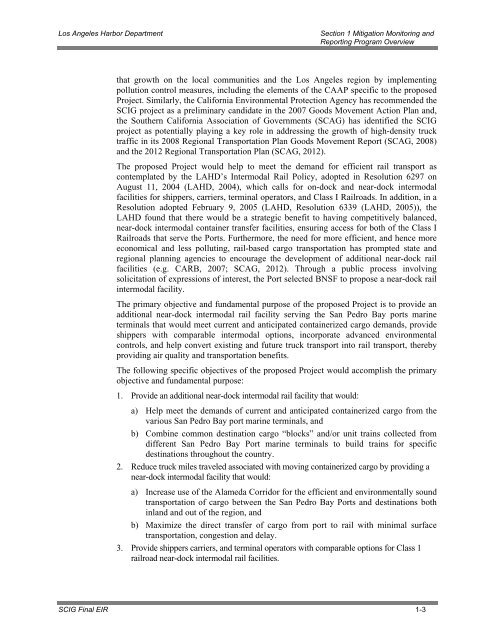Final Mitigation Monitoring and Reporting Program (MMRP)
Final Mitigation Monitoring and Reporting Program (MMRP)
Final Mitigation Monitoring and Reporting Program (MMRP)
You also want an ePaper? Increase the reach of your titles
YUMPU automatically turns print PDFs into web optimized ePapers that Google loves.
Los Angeles Harbor Department<br />
Section 1 <strong>Mitigation</strong> <strong>Monitoring</strong> <strong>and</strong><br />
<strong>Reporting</strong> <strong>Program</strong> Overview<br />
that growth on the local communities <strong>and</strong> the Los Angeles region by implementing<br />
pollution control measures, including the elements of the CAAP specific to the proposed<br />
Project. Similarly, the California Environmental Protection Agency has recommended the<br />
SCIG project as a preliminary c<strong>and</strong>idate in the 2007 Goods Movement Action Plan <strong>and</strong>,<br />
the Southern California Association of Governments (SCAG) has identified the SCIG<br />
project as potentially playing a key role in addressing the growth of high-density truck<br />
traffic in its 2008 Regional Transportation Plan Goods Movement Report (SCAG, 2008)<br />
<strong>and</strong> the 2012 Regional Transportation Plan (SCAG, 2012).<br />
The proposed Project would help to meet the dem<strong>and</strong> for efficient rail transport as<br />
contemplated by the LAHD’s Intermodal Rail Policy, adopted in Resolution 6297 on<br />
August 11, 2004 (LAHD, 2004), which calls for on-dock <strong>and</strong> near-dock intermodal<br />
facilities for shippers, carriers, terminal operators, <strong>and</strong> Class I Railroads. In addition, in a<br />
Resolution adopted February 9, 2005 (LAHD, Resolution 6339 (LAHD, 2005)), the<br />
LAHD found that there would be a strategic benefit to having competitively balanced,<br />
near-dock intermodal container transfer facilities, ensuring access for both of the Class I<br />
Railroads that serve the Ports. Furthermore, the need for more efficient, <strong>and</strong> hence more<br />
economical <strong>and</strong> less polluting, rail-based cargo transportation has prompted state <strong>and</strong><br />
regional planning agencies to encourage the development of additional near-dock rail<br />
facilities (e.g. CARB, 2007; SCAG, 2012). Through a public process involving<br />
solicitation of expressions of interest, the Port selected BNSF to propose a near-dock rail<br />
intermodal facility.<br />
The primary objective <strong>and</strong> fundamental purpose of the proposed Project is to provide an<br />
additional near-dock intermodal rail facility serving the San Pedro Bay ports marine<br />
terminals that would meet current <strong>and</strong> anticipated containerized cargo dem<strong>and</strong>s, provide<br />
shippers with comparable intermodal options, incorporate advanced environmental<br />
controls, <strong>and</strong> help convert existing <strong>and</strong> future truck transport into rail transport, thereby<br />
providing air quality <strong>and</strong> transportation benefits.<br />
The following specific objectives of the proposed Project would accomplish the primary<br />
objective <strong>and</strong> fundamental purpose:<br />
1. Provide an additional near-dock intermodal rail facility that would:<br />
a) Help meet the dem<strong>and</strong>s of current <strong>and</strong> anticipated containerized cargo from the<br />
various San Pedro Bay port marine terminals, <strong>and</strong><br />
b) Combine common destination cargo “blocks” <strong>and</strong>/or unit trains collected from<br />
different San Pedro Bay Port marine terminals to build trains for specific<br />
destinations throughout the country.<br />
2. Reduce truck miles traveled associated with moving containerized cargo by providing a<br />
near-dock intermodal facility that would:<br />
a) Increase use of the Alameda Corridor for the efficient <strong>and</strong> environmentally sound<br />
transportation of cargo between the San Pedro Bay Ports <strong>and</strong> destinations both<br />
inl<strong>and</strong> <strong>and</strong> out of the region, <strong>and</strong><br />
b) Maximize the direct transfer of cargo from port to rail with minimal surface<br />
transportation, congestion <strong>and</strong> delay.<br />
3. Provide shippers carriers, <strong>and</strong> terminal operators with comparable options for Class 1<br />
railroad near-dock intermodal rail facilities.<br />
SCIG <strong>Final</strong> EIR 1-3
















